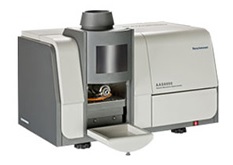
Instrument introduction
AAS6000 Series are Single Beam Atomic Absorption Spectrometers controlled and data processed by external computer and internal CPU chips. AAS6000 can be used to measure the concentration of macro, micro and trace metal elements and half-metal elements in various kinds of substances.
Atomic absorption spectrometry is a technique exploiting the fact that atoms at ground state may absorb the radiation of characteristic wavelength. As is known, the atoms are usually at ground state. For each element, the amount of energy required for an atom to transit from ground state to excited state is specific, and in general, is called characteristic wavelength. The Atomic absorption spectrometry typically makes use of hollow cathode lamp as the light source to emit the characteristic wavelength of a particular element. When the light passes through the atomic vapor, it is absorbed by the vapor. The concentration of the element can then be determined through the calculation of the absorption rate.
AAS6000 is provided with three reading methods Continuum, Retention and Peak Height for measuring absorbency, density and emission intensity. It has three signal modes: Atomic Absorption, Background Absorption and Background Correction Absorption, The reading time ranges from 0.5 s to 99s. AAS6000 include 8 computer controllable hollow cathode lamp holders. All working conditions of the instrument such as lamp number, lamp current, negative high voltage, working wavelength, slit, burner location, ignition/extinction and adjustment of burning ratio can be set by keyboard input. The functions of the instrument include automatic gain/ automatic zero, background correction, automatic energy balance, automatic peak location/wavelength scan, and automatic peak location on basis of the retrieval of peak values. All the readings, measurement results, calibration curves and operation conditions can be saved or printed out.
Host Machine
1、Total reflection achromatic optical system
Using concave mirror instead of convex lens, effectively solved the chromatic aberration problem of different focuses of different elements, and increased the efficiency of optical system.
2、C-T Monochromator
1800 lines/mm, blaze wavelength of 230nm beam-splitting system
3、8-element lamp turret
8 independent lamp power supplies, 7 lamps heating simultaneously at most while one is working, saving lamp changing and preheating time, the operation is more convenient as a result.
4、Full automatic design
The instrument is totally monitored and controlled by computer, except for mainframe power switch.
5、USB2.0 communication interface
Update the old RS232 mode into the latest USB2.0 mode, increasing the communication speed, and compatible with the new operation system.
6、Background correction system
Deuterium lamp background correction and self-reversal background correction, be able to correct over 30 times of background when background signal is 1A
7、Streamline sheet metal process design, modern stylish, elegant and beautiful
8、Proprietary intellectual property rights and powerful activity manager software
Humanized operation interface makes your operation easier; the interface of the software can be switched between English and Chinese. Full automatic qualitative and quantitative analysis can calculate element contents and generate report automatically.
Technical specifications
Model: AAS6000
Optical system: all-reflective single-beam CT optical path
Focal length of monochromator: 350mm, oil/water proof air compressor
Blazed wavelength of gratings: 230nm
Number of grating grooves: 1800g /mm
Wavelength range: 190nm-900nm
Wavelength accuracy: ±0.1nm
Wavelength repeatability: ±0.1nm
Spectrum bandwidth: 0.1nm, 0.2nm, 0.4nm, 0.7nm, 1.4nm
Noise: 0.005 Abs(static); 0.006 Abs(Dynamic)
Baseline drift: 0.003 Abs/0.5h; best performance
Background correction: D2 lamp + self reversal
Number of the lamps: 8
Number of preload lamps: software controlled, ≤8
Gas path safety measures: yes
Atomizer: flame atomizer
Automation: lamp / slit / wavelength / gas path / ignition / burner / safety measures / C2H2 monitoring
Application fields
Geology, minerals, metallurgy, steel, non-ferrous metals
Environmental analyses: air, water quality, soil and solid wastes
Petrochemical engineering, crude oil and related products, light industrial products,
Food, biomedicine and health products
Building materials (glass, ceramic, paints, etc)
Steel and non-ferrous metals analysis
Soil and solid wastes analysis
Biomedicine and health products analysis
Food analysis
